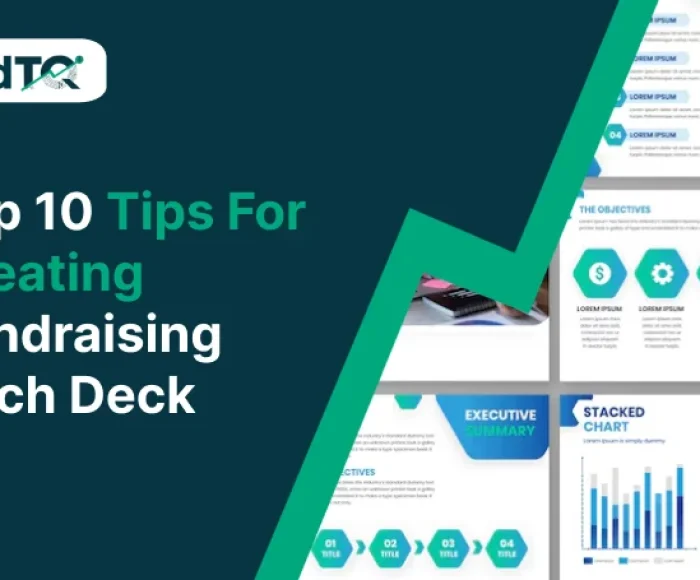Creating a compelling pitch deck is one of the most important tasks for a startup seeking investment. Many founders opt to build their pitch decks themselves, believing it will save time or money. However, this DIY approach often leads to critical pitch deck mistakes that turn investors away. In this blog, we’ll highlight five major reasons why DIY pitch decks fail to secure funding and what you can do to avoid them.
Bonus Tip:
You’re a startup but not sure how to find your business valuation? Don’t worry—use this free business valuation calculator to know your worth instantly!
10 Pitch Deck Mistakes
Following are the mistakes people make while creating a pitch deck-
1. Lack of a Catchy Opening and Coherent Narrative
Failing to capture the investor’s interest at the outset is one of the most frequent pitch deck errors in do-it-yourself presentations. The tone of the entire pitch is established by a memorable and catchy introduction. Many founders fail to see this because they dive right into the details without providing a compelling hook or engaging story.
Apart from the introduction, your pitch deck must have an integrated story that connects all the elements. Investors will find it difficult to understand and become disinterested if your slides seem haphazard or lack coherence. Make sure your pitch delivers an engaging tale about your company and makes sense in order to avoid making this error.
2. Information Overdose
Information overload is a common problem with do-it-yourself pitch decks. In their enthusiasm, founders attempt to provide every information about their firm, from industry statistics to product specifications. But packing your pitch with too much material will overwhelm potential investors. They need the big picture and the most crucial information right front because they don’t have time to sort through all the data.
Make sure your slides are clear and simple. At a follow-up meeting, give just enough details to draw attention and allow for questions. Steer clear of the pitch deck error of jamming each slide with too much intricate data and language.
3. Lack of Vision and Strategy
Another major pitch deck mistake that DIY presentations often make is failing to communicate a clear vision and strategy. Investors want to know where your startup is headed and how you plan to get there. Simply describing your product isn’t enough; you need to paint a bigger picture of your long-term goals, growth strategy, and potential market impact.
A lack of vision and strategy signals to investors that you may not fully understand your business’s potential or have a solid plan for scaling. Always focus on the “why” behind your product and the roadmap to achieving success.
4. Not Understanding Your Market and the “Why Now” Factor
Investors need to know two things: why your solution is necessary and why it’s the right time to invest. Many DIY pitch decks fail to demonstrate an in-depth understanding of their target market and current trends. Without this, it’s hard for investors to see the opportunity or urgency behind your business.
The “why now” factor is critical. Are there market trends or technological advancements that make your solution timely? If your pitch deck doesn’t answer these questions, you risk losing investor interest. Failing to show market knowledge is one of the most damaging pitch deck mistakes you can make.
5. Failing to Demonstrate Traction
Proof that your company is growing is what investors want to see. Demonstrating traction—whether through collaborations, revenue milestones, or user growth—is essential to persuading investors that your firm is headed in the right direction. DIY pitch decks lack credibility because they frequently minimize or exclude critical performance indicators (KPIs) that demonstrate success.
Whether it’s a successful beta launch or an expanding list of potential clients, you must demonstrate momentum even if you’re just getting started. To instill trust in investors about the future of your startup, always emphasize your accomplishments to date.
Avoid these mistakes and get investor-approved pitch decks
6. Flimsy Business Model
Presenting an unclear or badly written business model is one of the most common pitch deck errors in do-it-yourself decks. Investors want concise, in-depth descriptions of how your business intends to make money, expand, and maintain profitability. Investors become suspicious when founders don’t present reliable data or accurate revenue estimates.
They may wonder if you have carefully considered the operations and financial viability of your startup if your business plan is weak. Steer clear of generalizations and make sure your business strategy covers pricing tactics, sales channels, and how you want to grow your revenue sources.
7. Poor Competition Slides / Market Positioning
Another common pitch deck mistake is poorly executed competition or market positioning slides. Many DIY pitch decks either ignore competitors entirely or fail to properly highlight how their product stands out. Investors want to know how your startup compares to others in the space and how you plan to capture market share.
If your competition slide is too generic, overly crowded with information, or doesn’t accurately represent the market landscape, it weakens your overall pitch. A well-constructed competition slide should clearly identify competitors and articulate your unique value proposition. Make sure to use clear visuals or charts that help investors see why you’re positioned to win in the market.
8. Lackluster Team Slide
Investors don’t just invest in ideas—they invest in the people behind them. One of the biggest pitch deck mistakes is presenting a lackluster or underwhelming team slide. In a DIY pitch deck, founders often fail to showcase the strengths, expertise, and experience of the founding team, which is a critical component for investor confidence.
Your team slide should highlight not only the roles of key team members but also their relevant background and why they are uniquely positioned to execute the business plan. Investors want to feel assured that the people running the company have the skills, industry knowledge, and leadership capabilities to drive the startup’s success.
9. Unclear Funding Ask
An unclear or poorly specified funding request is frequently the result of a do-it-yourself strategy. Investors must understand precisely how much money you are looking for, how it will be used, and how it will assist your firm reach certain goals. Leaving investors wondering how their money will be used is one of the most important pitch deck errors.
Be precise and explicit in your fundraising request to prevent this. Whether you plan to use the money for employment, marketing, product development, or growth, break it out. Reassuring investors of the return on their investment also requires financial predictions that demonstrate how the investment will support growth.
10. Pitching the Wrong Investor
Even the most polished pitch deck won’t secure funding if it’s being presented to the wrong investors. One major pitch deck mistake DIY founders make is failing to tailor their pitch for the right audience. Some investors focus on specific industries, funding stages, or types of businesses, so understanding your investor’s preferences is crucial.
Before reaching out to potential investors, do your homework. Research their portfolio, investment criteria, and whether they have a history of investing in startups like yours. Customizing your pitch deck for your audience can greatly increase your chances of receiving funding. A one-size-fits-all approach is rarely effective in the competitive world of venture capital.
Final Thoughts
While a DIY pitch deck might seem like a cost-saving option, it often leads to significant pitch deck mistakes that reduce your chances of securing funding. From a weak business model to an unclear funding ask, these errors can signal to investors that you’re not ready for investment. Taking the time to create a professional, well-researched pitch deck can make all the difference in getting the funding your startup needs to grow.
Avoid these common mistakes, and your pitch deck will be one step closer to winning over the investors you need to succeed.
Also Read: Top 5 Fundraising Mistakes Startups Make – And How to Avoid Them




Comment (01)